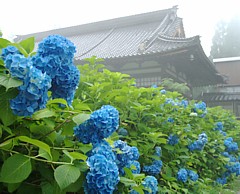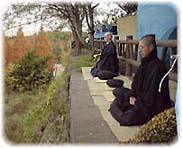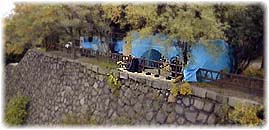|
|---|
 How to sit 6 Sesshin without toys (Adult Practice XXVI) |
Reading Keizan's
Zazen-yojinki, it is quite obvious that he thinks not only of sitting indoors, but also considers "green waters, deep mountains and hidden valleys", but warns against robbers, fires, floods, women ("widows, virgins, whores and dancing girls"), politicians and other evils. He also doesn't recommend sitting in high places (cliffs etc.).
In the park in Osaka I also found that sitting in high spots (like on top of the moat, where I sat) will help you to stay awake, but it is cold in winter and can be extremely dangerous when you are really tired, and maybe that is why it is said in the next section:
Summarized in "Shikantaza" as: Here Keizan recommends "eating two parts out of three and leaving one". I do not think that he means that we should leave one third of our meal untouched, but rather one third of our stomachs empty. Sawaki allows for a stomach to be "eighty percent full". Both warn against food that is hard to digest and upsets our body. Another of the changes that I made three years ago is the sesshin schedule. The so called Antaiji style sesshins were created by Uchiyama Roshi almost 40 years ago, after Sawaki Roshi had died and Uchiyama became the next abbot. The idea of this schedule is that the whole sesshin should be like one single sitting of zazen. There were no more Dharma talks during sesshin, no monks walking around with the wake-up stick, no cleaning, no work, no sutra chants, no talking, nor bath or shower during those retreats. Uchiyama himself called them "sesshins without toys". For five days in a row, people had the chance to be absorbed in zazen and let themselves be themselves only by themselves. These sesshin were practiced around the first sunday of each month, except for the months of February and August, when there was no sesshin, and July and September, when the sesshin was only three days long. On all sundays outside these regular sesshins, there were "one-day sesshins".
Above you can find the sesshin schedules of the "old" Kyoto Antaiji and the "new" Antaiji in Kutoyama until 2002. While sesshins were held only once each month (with the exception of August and February) at the Kyoto Antaiji, at the "new" Kutoyama Antaiji sesshins are held twice each month (one five days and one three days long), except for August, when there is no sesshin, January, when there is only one three day sesshin, and December, when there is only one eight day sesshin. There are only few minor differences between the two schedules though: While all periods where 50 minutes long in Kyoto, the four periods at the beginning of each block (of two, five, five and two periods) of zazen were extended by ten minutes, while the three periods before each meal were reduced to 40 minutes. That means that we had 4 one-hour periods, 7 fifty-minute periods, and 3 forty-minute periods during the day. Now, three years ago I changed the sesshin schedule as follows:
There are only two meals now during sesshin, one extra period of zazen, but each period is only 45 minutes long (except for the first one in the morning). That means that we actually sit 20 minutes per day less on the cushion (690 minutes instead of 710), but have more kinhin (180 minutes instead of 100) and less time to rest. Also, we used to do 20 to 30 minutes of cleaning after lunch on the 3rd and 5th day, but there is no more cleaning during sesshin with the present schedule. Now, what were the reasons for this change? Actually, there were a couple of reasons that led me to the decision to change the schedule, the most important ones had to do with the meals and with physical exhaustion. But let me continue about this next month.
to be continued ... (Docho)
|
|---|
 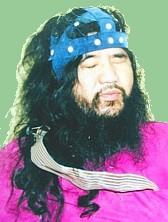 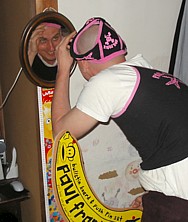 The Aum incident defined as an attack on modern human civilization (Part 3) |
"When we examine the Aum incident, we can discover in it the cultural and social sickness of our modern world. The incident itself will sooner or later be forgotten. But the sickness of our modern world itself that manifested in the attacks will not so easily be cured. As long as we experience this feeling of suffocation in modern society, the 'Aum problem' will not be solved, and a second or third 'Aum incident' can occur in a different form any time. This means that the so-called 'Aum problem' is a problem of each of us - it is 'our problem'" (All quotes are translations from the proceedings of the symposium on the "Aum incident", that appeared on the Japanese homepage of the Institue of Zen Studies (in Japanese: www.zenbunka.or.jp/03_magazine/index5_2.htm)) The Rinzai and Ôbaku sect thus defines the "Aum incident" as "our problem". Now, how do they analyze the problem of modern society that manifested in the incident? "Modern man believes in the human being rather than in God, and modern society and history have been structured with the human being at the center. By freeing man out of the hand of God though, modern Humanism has made us the slaves of our own human karma. In the modern world, the prospect of a 'different world' beyond our human karma has been eliminated. Therfore, modern man has started to suffer from being a 'human being', and he feels that he is suffocating from his isolation in this modern human world, where there is no way to escape out off. We human beings have the right of free speech and can pursue our happiness unhindered. Still, we are dissatisfied with our basic condition and secretly wish we could be something else than what we really are. We don't want to be where we are right here and now, but look for our 'real selves' and our 'true homes'. Thus, we try to escape from and deny the human world, only to become isolated and lonely. And although we feel angry and upset about the 'Aum incident', we can not help but sympathize with those young people who felt drawn towards the cult. That is because we can see in them the suffering of everyone living in this modern world. They - just like everyone of us - are victims of the isolation in the present human society. The reason why we feel both anger and sympathy at the same time when thinking about the Aum incident, lies in the fact that it appears to be a challenge towards modern Humanism, that aims both at destroying and transcending it - be it for better or worse." Rather than simpling putting the blame on the Aum cult, the Rinzai and Ôbaku sect officials even seem to sympathize with the way the cult challenged modern Humanism. On the other hand though, the question poses itself why the cult couldn't transcend modern Humanism, and why its challenge ended with the Salin attack: "Although the cult tried to transcend modern Humanism, it is exactly because it chose modern Humanism as the object of its challenge, that naturally it internalized that same Modernism which it tried to transcend. Thus the cult internalized Modernism not only as the object of its challenge, but also the teaching of its leader, Asahara Shôkô, and the way their religious practice was designed and organized, are modern and humanistic in their essence. That means that while the cult tries to challenge modern Humanism, it carries in itself all the defects of modern Humanism that it tries to overcome." What does this mean concretely? "What they call 'liberation' means the transcending of the ego-self which leads to the mystical experience of some objective reality behind it. The experience of this 'true world' is supposed to give the individual mystical powers of some kind. What is essentially missing in this concept of 'liberation' is the reflection on the ego-self that desires to make this mystical experience. They have lost sight of themselves, being focused on some 'true reality' beyond themselves. Thus they do not realize that they themselves create the karma that they try to escape out off: By chasing after a great hallucination which they call 'liberation' - rather than reflecting on themselves who craeted this hallucination in the first place - they get lost deeper and deeper in the illusion they try to escape from. Human existence means in its essence deep karmic bondage. But the followers of this cult don't know that. They just try to transcend the karmic bondage that presents itself in the form of modern Humanism, thus getting trapped even deeper in the dead end road of karma. The more they try to transcend themselves and make mystical experiences on higher spiritual levels, hoping to attain some spiritual power or liberation, the more they get enslaved by their own karma. Cults like the Aum cult have existed long ago. And long ago, human kind realized the karmic trap that the pagan superstitions taught by these cults lead us to. Thus human kind discovered what religion really means: To be religious means to realize that you are wandering around inside the delusion created by your own ego-desires. To reflect on yourself, be sad about the delusion you create, and pray inside this sadness - that is the world of religion. Prayer is the manifestation of the wish to give up your ego and live together with everything else, being held alive by that eternal life force that embraces each and all of us. When human kind discovered this form of religion, we encountered for the first time that reality that both transcends and at the same time embraces all of our karmic delusions. Religion means the world that opens up when we pray in such a way. But the Aum cult did not know this form of prayer, they did not know the world that both transcends and embraces all our human delusion and suffering. They have never dreamt of the four vows to save the uncountable suffering beings, extinguish the delusion that can never be extinguished, study the numberless dharma gates and realize the buddha way that transcends all. This is also proven by the fact that Asahara, while talking about 'mahamudra', never had the experience of great death himself. The followers of the Aum cult all knew in some way or the other that feeling of suffocation that comes from living as a human being in this modern world. What they didn't know though, is that there is a world that embraces us as human beings, and that this world opens up for us when we only reflect on orselves as limited human beings and accept our suffering as an essential condition of our human existence. What they tried was rather to gain mystical powers that would free them from their suffering. Thus they negated their essentially being human, and they finally started to think of themselves as the 'elected ones', having the right to kill others as a means to improve their victim's karma (powah)". Å@ What seems to be most interseting for me here is the fact that the officials from the Rinzai and Ôbaku sect, that seems to put strong emphasis the concept of "experiencing kenshô and becoming a buddha", here take refuge in the word "prayer", which is usually not encountered in their teaching. It reminds me of Uchiyama Rôshi explaining the practice of just sitting with the words "vow (seigan)" and "repentance (zange)". Zazen is not a way to transcend oneself as a human being and become something special - "an enlightend one, a buddha" - but rather a practice of vow and repentance. The vow being the expression of the wish in each of us to overcome our ego-desires, the repentance coming from the reflection with "buddha eyes" on ourselfs as we are: human beings with ego-desires. This awareness is obviously not restricted to Sôtô Zen, but exists in Rinzai and Ôbaku Zen as well. So the question remains: What solution does Rinzai and Ôbaku Zen offer to the problem posed by the Salin attck, which they define as "our problem". What do WE have to do to guide a way for the young people suffocating in modern society?
to be continued ... (Muho)
|
|---|
|
|
Greetings Docho-san,
I must first apologize for not having submitted to you my written contribution to this month's Lotus in the Fire. I have written something the past few days which I am not quite satisfied with; everyday it seems that I remember or discover something and I want to write more about it into the whole text. Sometimes what I write doesn't capture the feeling I want until I rephrase things. Since you must be already finished with publishing the entire newsletter by this time, I hope that it will be alright for me to submit my writing in the next few days for the following edition of Lotus in the Fire, which I presume is in June. I am with Chigusa at the moment, and we have spent much time talking about Antaiji. She has been eager to see what it has done for me, and how it may have changed me. She searched the internet recently and has found the 10min. 16sec. RealPlayer video clip from YTV with Johann. We have watched it together, and I thought it was rather short. Chigusa gives a warm hello to you and to Tomomi-san. She wants to come to Antaiji and see for herself what it is like. She and I were discussing the posture of zazen yesterday. I am impressed that she sits kekkafuza effortlessly without immediate pain in her legs. She has never sat before, and yet astonishingly, she sat for fifty minutes without flinching. I wonder when I will be able to do the same. I am deciding which zafu and zabuton to purchase online. There are quite a few places selling them. I am nostalgic about many things at Antaiji, and I am also much more appreciative of the life here. I have allowed my growth in attachment to Chigusa, something that I previously feared would affect the quest to fulfil my deep need in searching for that elusive something which I could not find so far in my life. I would like for her to meet you and Tomomi and Daido and Tassho one day. I hope everything is well at Antaiji, and Megumi and Hikaru are happy and healthy. Say hello to Daido and Tassho and Johann and Daniel (if he's there). You must all be enjoying Johann's food when he is tenzo. I want to see you all again soon. Goodbye for now, Adam P.S. If you want, you can take this e-mail and place it in your Lotus in the Fire edition for this month as my contribution. I think it would be something different for your newsletter. |
|---|
